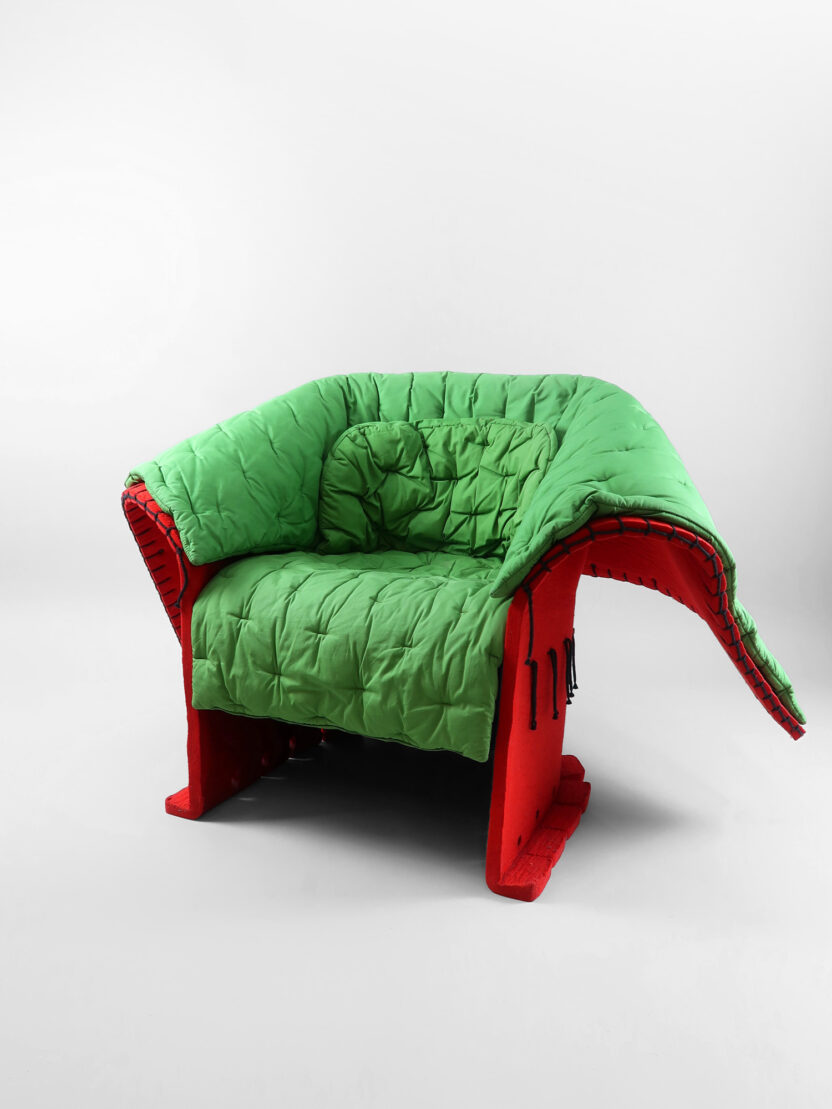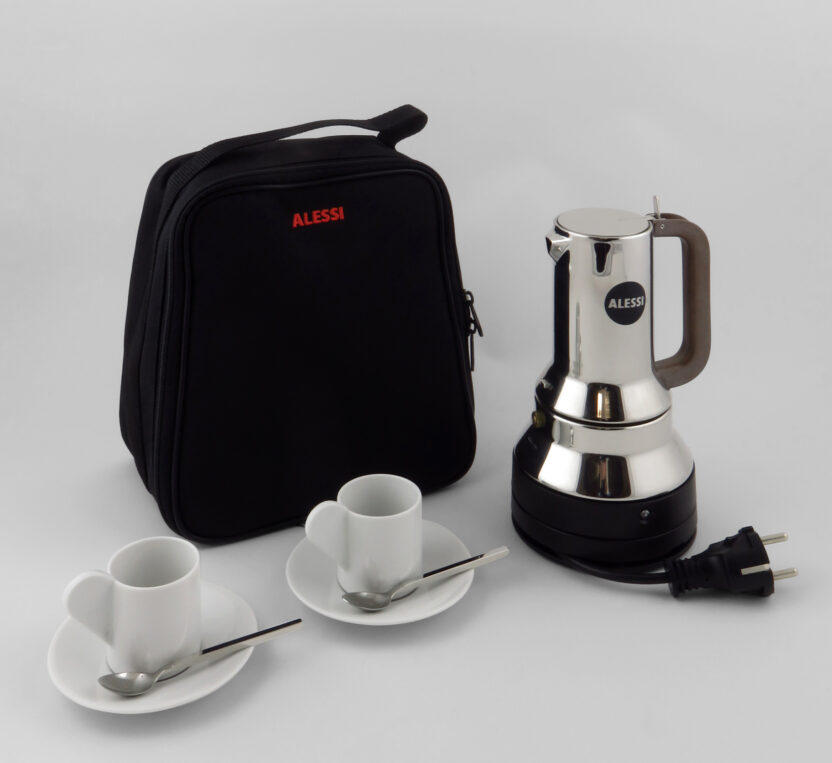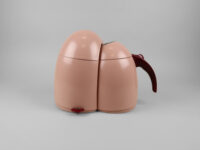
Ship of Fools
Transports of Delight?
Design Museum Gent is closed. The museum is getting a new wing and a complete renovation. Fortunately, part of the collection will remain on display at other locations in Belgium and abroad. Frac Grand Large is the first stop. In a fictional tale of a miraculous draught of fishes on the seventh continent, the exhibition Ship of Fools brings together various odd objects from the Design Museum Gent collection, together with a selection of films and other works by artists. The exhibition focuses on the transport craze – the steadily evolving mobility of objects, materials and people – from the 1950s up to the present day. A contemporary echo of Hieronymus Bosch's late-medieval Ship of Fools, the Frac Grand Large event depicts the possible end of our opulently materialistic societies. Sacrifice or rescue?
Transport: loss of meaning and vital quest

The underlying thesis of the exhibition is that of a specifically post-war Western lunacy gripping humans and their objects: an unreasoning yen for transport. This frenzy is evident today in fantasies of exoticism, in the consumption of weekends, travel and export objects, in the frantic pace of our journeys, in the fetishisation of cars, planes, rockets, and so on.
Originally the notion of ‘transport’ was associated with strong emotion. The amorous transports of medieval literature called on the potent desires of courtly love, the magnetism of the muses and troubadours, the passionate feelings that were the driving force behind heroic sagas. Later, around 1650, ‘transport of the brain’ designated the delirium and mental turmoil caused by fevers that wrenched victims out of their normal state. Transport is thus a state of being far more disruptive than simple displacement, and yet it is a crisis of displacement that we are facing: scarcity of fuel, massive clandestine migrations, epidemics, border closures. So, can our need for transport be called into question? The Ship of Fools narrative steers us in this direction: over the centuries transport remains a pointer to loss of meaning and quests for vital energy.
The late Middle Ages according to Bosch and Brandt
The painting by Dutchman Hieronymus Bosch and the text by the German humanist and poet Sebastian Brandt that this exhibition refers to are both called Ship of Fools. Dating from around 1500, they conjure up a period of transition towards a new society: the passage from the Middle Ages to the Renaissance, a period of crisis and of moral, social and aesthetic breakdown. In Bosch's picture the ship stands for a means of escape in the tradition of such parables of the Flood as Noah's Ark. In a makeshift boat, a handful of alienated men and women set sail in the hope of a miracle or another reality. The Ship of Fools represents both a way out and an imprisonment.
In the Middle Ages madness was an admissible subject for painting: Bosch, for example, devoted a number of pictures to human derangement. At a time when religion was losing its hegemony owing, among other things, to scientific advances, pagan and vernacular beliefs were multiplying and giving rise to fantastic imaginings and anguish with regard to the underworld. In Bosch's landscapes, angels rub shoulders with chimeras, sea monsters and spectres; in the midst of this disorder, humans must find the meaning of their passage on Earth. Now in the Louvre, Bosch's Ship of Fools will not be presented on the walls of the Frac Grand Large; but the ship's spirit will float through the exhibition like a ghost.
The Design Museum Gent collection

Richard Sapper, Alessi, RS 07, 2002. Photo: Design Museum Gent
The objects making up the Design Museum Gent collection embody both concrete transport, moving from one point to another, and perspectives of transformation, transition and translation, passages from one state to another.
A Mickey Mouse funnel, a mirror screen, a chrome toaster, travel clocks and alarm clock, a silver centrepiece in the luxury liner silver tradition, a collection of food cans, spoons, ladles and knives, a bathtub, a radio, a TV set, two bedside lamps embellished with bird's wings, a silver condom holder, ties with virus and explosion patterns, an orthopaedic prosthesis, a baby's plastic drinking glass, a thermos flask covered with faux fur – and the list goes on.
These objects have been chosen for their narrative and semiotic functions – objects as signs – not for their style. They present uses while offering hints of obsolescence, absurdity, datedness, humour, kitsch and the imaginative ethos of the second half of the 20th century. Once brought into interaction, their eclectic aesthetics reflect the complexity of our relationships with materiality and its contingent consequences for human societies. Items that are rare and precious yet with no speculative value, little shown in museums, they each have their raison d'être. Their beauty lies in what made them a necessity for their creators and users at a given point in time.

Alessandro Mendini, Philips, Alessi, HD 2004/A, 1994. Photo: Design Museum Gent.
Films and images by artists
A number of works by artists accompany the design collection and generate its inner tension.
It did not happened with us, yet. The work of Chto Delat, the Russian collective of artists and activists, the film Safe Haven is set on a Norwegian island identified by a political network as a "haven of peace" for artists whose lives and freedom of expression are under threat. In a story based on fact a poet, a woman artist, a curator, a philosopher and an activist arrived on the small island of Sula for a creative residency. The inhabitants welcome them onto their island, while being fully aware of the difficulty of creating when the voyage has a touch of exile about it. They explain their thinking on the subject eye to eye with the camera, while the visitors describe the political situation, recount their ideas and perform abstract gestures with the horizon as a backdrop. One foggy day, at the foot of a lighthouse, the issue of returning is raised: one after the other they intone, "stay far away" and "stay out there".
This video echoes three other films and an audio work, each of which uses aesthetic singularity to address the imaginings and speculations that arise from the movement of humans and objects around the world. American artist Amie Siegel’s Provenance focuses on an emblem of mid-century modernist design—the furniture designed by the Swiss architect Pierre Jeanneret for the buildings of Chandigarh, the controversial modernist city in India. Beginning with the furniture’s present circumstances as decoration in wealthy homes, the work then traces the furniture’s journey in reverse chronology through warehouses, on display at American and European auctions, at a furniture restorer’s, on a cargo ship, and, finally, back to their origins in Chandigarh. In their original context, these prized pieces function as everyday office furniture. Their migration as the spoils of modern design discloses the gulf between disparate settings, mapping the undercurrents of larger movements of capital.
In quite a different way, Studio Swine‘s film Sea Chair presents the shaping and recycling of materials, in this case waste recovered at sea and transformed into museum objects: a design approach more narrative than formalist. The film traces the process of manually fabricating stools out of melted plastic – one-off pieces produced from detritus netted with fishing catches or harvested at sea or onshore.
Salt in the Veins by Italian woman director Vittoria Soddu documents a creative activity practised by members of an English choir: the performance of traditional sea shanties from different periods. Even removed from its real-life context of ship decks and harbours, this cultural heritage retains its great evocative power for its revivalists. The film unfolds with the songs and their staging, going from harmony to collective trance as the artist restores the age-old need to sing together against wind and tide.
Blanche Endive (White Endive) is the work of composer-conductor Gabriel Mattei, after a libretto by artist Grégoire Motte. Taking up themes central to Motte's imagination, the composition is based on four intertwined stories: the invention of chicory stockings in 1942, the troubadour Jaufré Rudel and the Distant Princess, the transformation of nylon stockings into parachutes and the failed casting of beauty queen Miss Valenciennois' leg. Performed by children from the Lille Centre Music School, this lyrical drama in four acts takes us on a journey to Antioch and finally back to a beach in Calais.
The group of featured artworks also includes Alan Sekula's photograph The Ships of Fools, from the Frac Grand Large collection, as well as Matali Crasset's Quand Jim monte à Paris (Jim Goes to Paris) and Panamarenko's Spar convenience store bag are also part of the ensemble.
Exportation, exile, real or fantasized exploration – these works welcome into their screenings the objects of the Design Museum Gent collection, as both strangers and friends.
Staging and scenography
The exhibition will take place mainly on the 3rd floor of the Frac Grand Large. One of the films will also be shown in the projection room on the 5th floor.
The composition and presentation of the exhibition space will be structured around three themes:
- Vanity Cases will bring together objects designed for material travel.
- Kitchen Tour will address the transformations of materials and uses in domestic settings, notably the kitchen, and the fantasies of exoticism associated with them.
- Self Transports, the last and most substantial segment, will open a window onto the crazed need for other things and other places, and different ways of fleeing, confronting, adopting or resisting it; the objects will be seen as bypasses, both aesthetic and metaphysical, of our here and now.
The scenography will be created by interior designer Julien Carretero.
Visiting information
Ship of Fools. Transports of Delight?
02.04.2022 — 31.12.2022
On display in Frac Grand Large (503 av. des Bancs de Flandres, Dunkirk, France)
Admission: € 4 | € 2 | € 0
Saturday & Sunday (April - September): 11:00 - 19:00
Saturday & Sunday (October - March): 10:00 - 18:00
Closed on 25 December
Sandra Plasschaert
Cats Communication
Press & PR
+32 479 35 10 39
sandra@catscommunication.be
Simon Adriaensen
Design Museum Gent
Communication
+32 9 323 64 88
simon.adriaensen@stad.gent